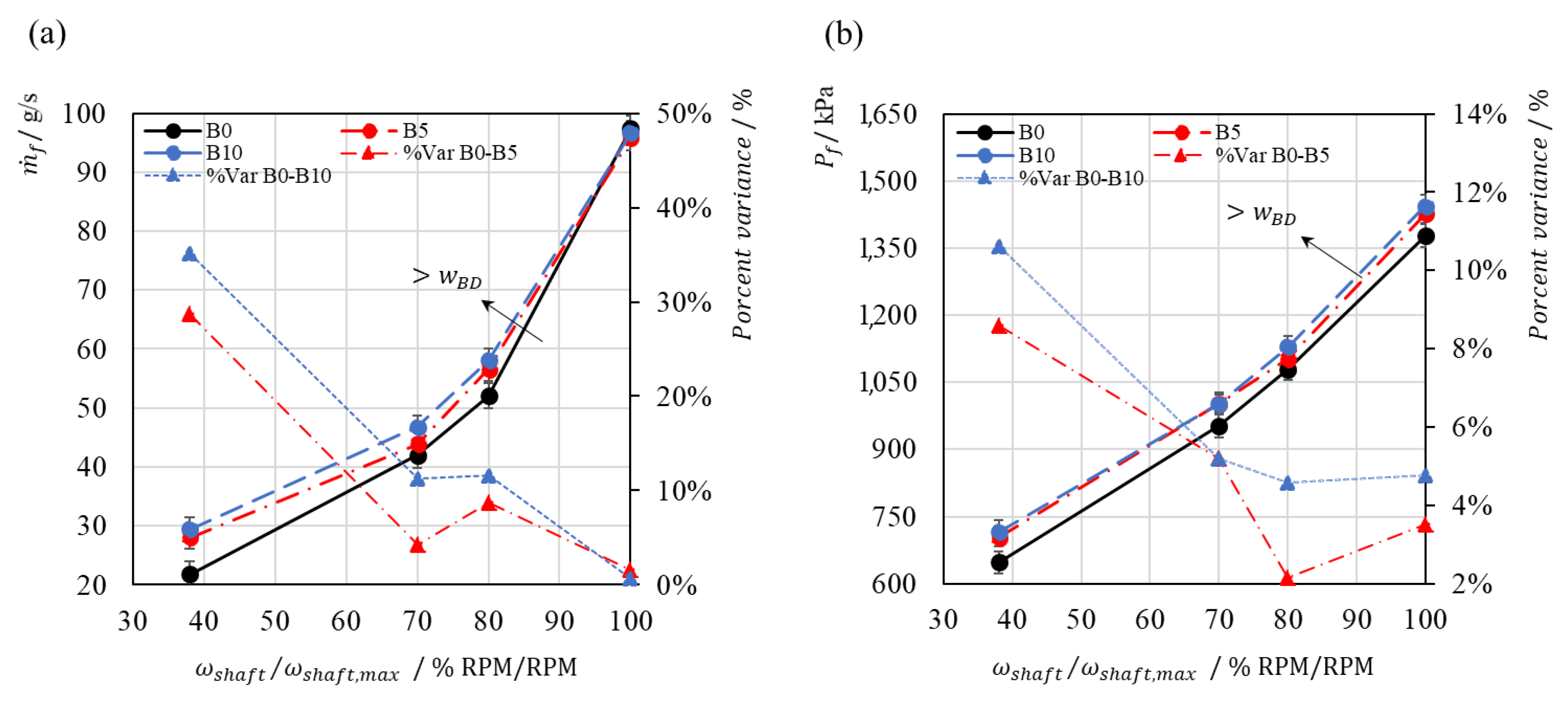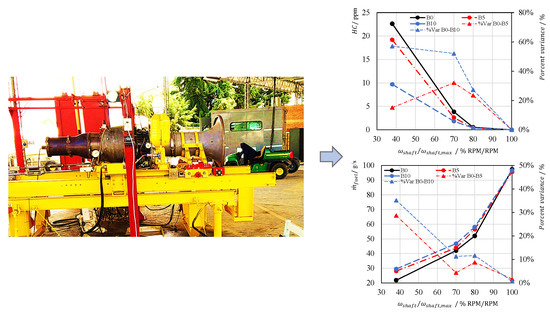Experimental Methodology and Facility for the J69-Engine Performance and Emissions Evaluation Using Jet A1 and Biodiesel Blends
Abstract
:1. Introduction
2. Materials and Methods
2.1. Experimental Facility and Procedure
2.2. Experimental Planning and Data Processing
3. Results and Discussion
4. Conclusions
Author Contributions
Funding
Acknowledgments
Conflicts of Interest
Abbreviations
| Symbol | Definition | Units |
| Percent excess combustion air | % g/g | |
| Fuel pressure | kPa | |
| Fuel mass flow | g/s | |
| Biodiesel volume content in fuel blend | % v/v | |
| Main shaft rotational speed | RPM | |
| Air/fuel ratio | g/g | |
| Exhaust gas temperature | - | |
| Higher heating value | MJ/kg | |
| Thrust force | N | |
| Outside Air Temperature | °C |
References
- Abu Talib, A.R.; Gires, E.; Ahmad, M.T. Performance Evaluation of a Small-Scale Turbojet Engine Running on Palm Oil Biodiesel Blends. J. Fuels 2014. [Google Scholar] [CrossRef]
- Teske, S. Achieving the Paris Climate Agreement Goals: Global and Regional 100% Renewable Energy Scenarios with Non-Energy GHG Pathways for +1.5 C and +2 C; Institute for Sustainable Futures University of Technology Sydney, Ed.; Springer: Sydney, NSW, Australia, 2019; ISBN 9783030058432. [Google Scholar]
- Kandaramath Hari, T.; Yaakob, Z.; Binitha, N.N. Aviation biofuel from renewable resources: Routes, opportunities and challenges. Renew. Sustain. Energy Rev. 2015, 42, 1234–1244. [Google Scholar] [CrossRef]
- Coban, K.; Colpan, C.O.; Karakoc, T.H. Application of thermodynamic laws on a military helicopter engine. Energy 2017, 140, 1427–1436. [Google Scholar] [CrossRef]
- Corporan, E.; Reich, R.; Larson, V.; Aulich, T.; Mann, M.; Seames, W. Impacts of biodiesel on pollutant emissions of a JP-8–fueled turbine engine. J. Air Waste Manag. Assoc. 2005, 55, 940–949. [Google Scholar] [CrossRef] [PubMed]
- Nascimento, M.A.R.; Lora, E.S.; Corrêa, P.S.P.; Andrade, R.V.; Rendon, M.A.; Venturini, O.J.; Ramirez, G.A.S. Biodiesel fuel in diesel micro-turbine engines: Modelling and experimental evaluation. Energy 2008, 33, 233–240. [Google Scholar] [CrossRef]
- Chiaramonti, D.; Rizzo, A.M.; Spadi, A.; Prussi, M.; Riccio, G.; Martelli, F. Exhaust emissions from liquid fuel micro gas turbine fed with diesel oil, biodiesel and vegetable oil. Appl. Energy 2013, 101, 349–356. [Google Scholar] [CrossRef]
- Sundararaj, R.H.; Dinesh, R.; Kumar, A.; Sekar, T.C.; Pandey, V.; Kushari, A.; Puri, S.K. Combustion and emission characteristics from biojet fuel blends in a gas turbine combustor. Energy 2019, 182, 689–705. [Google Scholar] [CrossRef]
- Udeh, G.T.; Udeh, P.O. Comparative thermo-economic analysis of multi-fuel fired gas turbine power plant. Renew. Energy 2019, 133, 295–306. [Google Scholar] [CrossRef]
- Harahap, F.; Silveira, S.; Khatiwada, D. Cost competitiveness of palm oil biodiesel production in Indonesia. Energy 2019, 170, 62–72. [Google Scholar] [CrossRef]
- Hoxie, A.; Anderson, M. Evaluating high volume blends of vegetable oil in micro-gas turbine engines. Renew. Energy 2017, 101, 886–893. [Google Scholar] [CrossRef]
- Allouis, C.; Beretta, F.; Minutolo, P.; Pagliara, R.; Sirignano, M.; Sgro, L.A.; Anna, A.D. Measurements of ultrafine particles from a gas-turbine burning biofuels. Exp. Therm. Fluid Sci. 2010, 34, 258–261. [Google Scholar] [CrossRef]
- Chiong, M.C.; Chong, C.T.; Ng, J.H.; Lam, S.S.; Tran, M.V.; Chong, W.W.F.; Mohd Jaafar, M.N.; Valera-Medina, A. Liquid biofuels production and emissions performance in gas turbines: A review. Energy Convers. Manag. 2018, 173, 640–658. [Google Scholar] [CrossRef]
- Rochelle, D.; Najafi, H. A review of the effect of biodiesel on gas turbine emissions and performance. Renew. Sustain. Energy Rev. 2019, 105, 129–137. [Google Scholar] [CrossRef]
- Čerňan, J.; Hocko, M.; Cúttová, M. Safety risks of biofuel utilization in aircraft operations. Transp. Res. Procedia 2017, 28, 141–148. [Google Scholar] [CrossRef]
- Badami, M.; Nuccio, P.; Signoretto, A. Experimental and numerical analysis of a small-scale turbojet engine. Energy Convers. Manag. 2013, 76, 225–233. [Google Scholar] [CrossRef]
- French, K.W. Recycled fuel performance in the SR-30 gas turbine. In Proceedings of the 2003 American Society for Engineering Education Annual Conference Exposition, Nashville, TN, USA, 22–25 June 2003. [Google Scholar]
- Habib, Z.; Parthasarathy, R.; Gollahalli, S. Performance and emission characteristics of biofuel in a small-scale gas turbine engine. Appl. Energy 2010, 87, 1701–1709. [Google Scholar] [CrossRef]
- Lupandin, V.; Thamburaj, R.; Nikolayev, A. Test results of the OGT2500 Gas Turbine. Engine Running on Alternative Fuels: BioOil, Ethanol, BioDiesel and Crude Oil 2005. In Proceedings of the ASME Turbo Expo 2005. Power for Land, Sea, and Air, Reno, NV, USA, 6–9 June 2005; pp. 421–426. [Google Scholar]
- Bayona-Roa, C.; Solís-Chaves, J.; Bonilla, J.; Rodriguez-Melendez, A.; Castellanos, D. Computational Simulation of PT6A Gas Turbine Engine Operating with Different Blends of Biodiesel—A Transient-Response Analysis. Energies 2019, 12, 4258. [Google Scholar] [CrossRef]
- Teledyne Continental Aviation and Engineering—CAE. Technichal Manual T.0. 2J-J69-72 Intermediate Maintenance Instructions Turbojet Engine Model No. J69-T-25-A; US Air Force: Oklahoma City, OK, USA, 2004.
- Choi, S.; Lee, D.; Park, J. Ignition and combustion characteristics of the gas turbine slinger combustor. J. Mech. Sci. Technol. 2008, 22, 538–544. [Google Scholar] [CrossRef]
- Kimble-Thom, M.A.; Stanley, D.L.; Cholis, J.T.; Lopp, D.W. The Use of Bio-Fuels as Additives and Extenders for Aviation Turbine Fuels. In Proceedings of the ASME 1999 International Gas Turbine and Aeroengine Congress and Exhibition, Indianapolis, IN, USA, 7–10 June 1999; ASME: New York, NY, USA, 2014. V002T01A007. [Google Scholar]






| General Specifications of the J69 Engine | |
|---|---|
| Engine reference | Teledyne CAE J69 |
| Variant | J69-T-25A |
| Engine type | Turbojet—Single spool |
| Rotational speed max./RPM | 21,730 |
| Thrust max./N | 4560 |
| EGT max./°C | 663 |
| Compressor type | Centrifugal—1 stage |
| Inlet air flow max./kg/s | 9.07 |
| Pressure ratio max. | 3.9 |
| Turbine type | Axial flow—1 stage |
| Fuel distributor | Centrifugal/Slinger holes |
| No. Of fuel injectors | 2 |
| No. Of Slinger Holes | 16 |
| Fuel type | JP-4, Jet A, Jet A1 |
| Fuel consumption max./g/s | 143.6 |
| Operating Environment | |
| Location | Madrid, Colombia |
| MSN/m | 2554 |
| OAT/°C | 16–26 |
| RH/% | 25–56 |
| Patm/hPa | 1017 |
© 2019 by the authors. Licensee MDPI, Basel, Switzerland. This article is an open access article distributed under the terms and conditions of the Creative Commons Attribution (CC BY) license (http://creativecommons.org/licenses/by/4.0/).
Share and Cite
Talero, G.; Bayona-Roa, C.; Muñoz, G.; Galindo, M.; Silva, V.; Pava, J.; Lopez, M. Experimental Methodology and Facility for the J69-Engine Performance and Emissions Evaluation Using Jet A1 and Biodiesel Blends. Energies 2019, 12, 4530. https://doi.org/10.3390/en12234530
Talero G, Bayona-Roa C, Muñoz G, Galindo M, Silva V, Pava J, Lopez M. Experimental Methodology and Facility for the J69-Engine Performance and Emissions Evaluation Using Jet A1 and Biodiesel Blends. Energies. 2019; 12(23):4530. https://doi.org/10.3390/en12234530
Chicago/Turabian StyleTalero, Gabriel, Camilo Bayona-Roa, Giovanny Muñoz, Miguel Galindo, Vladimir Silva, Juan Pava, and Mauricio Lopez. 2019. "Experimental Methodology and Facility for the J69-Engine Performance and Emissions Evaluation Using Jet A1 and Biodiesel Blends" Energies 12, no. 23: 4530. https://doi.org/10.3390/en12234530







